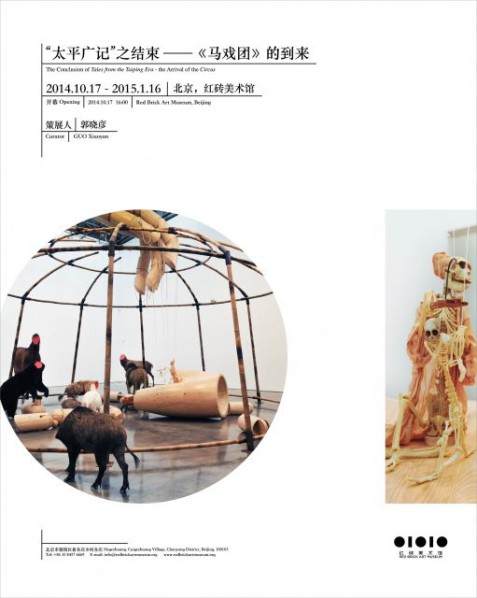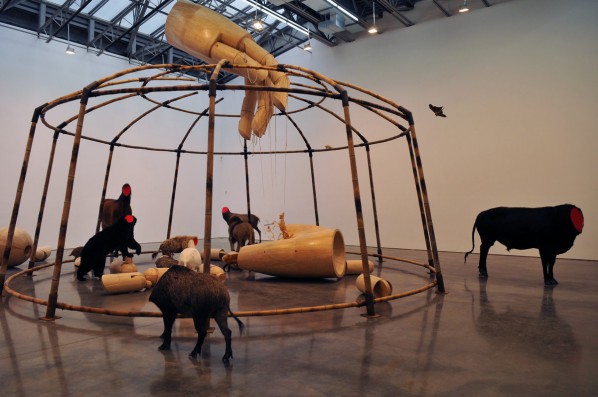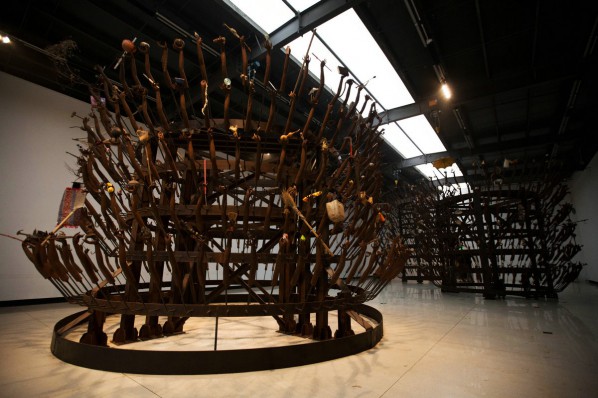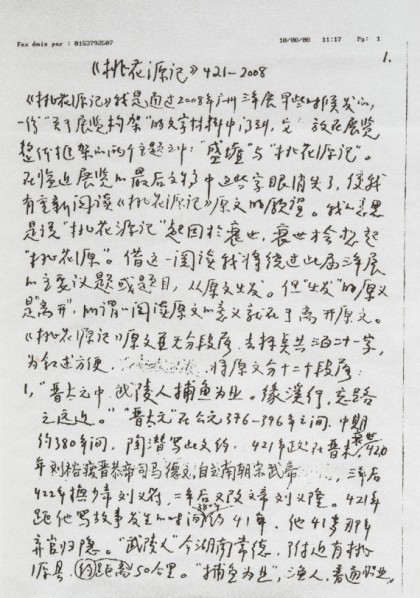
Despite the conclusion of Tales from the Taiping Era, the time-space continuum created by the exhibition, indicating the power of omens, unnatural events and visions still remains. The delayed arrival of the Circus became an opportunity to re-start the journey. Today, the Circus is not just a rhetorical metaphor, but is particularly relevant to our reality: the seemingly magnificent circus has actually lost its ring-master. And while making the work, Huang Yongping was certainly referring to a larger time-space: the end of time, the end of the world.

Huang Yongping, Circus, 2012; Wood, bamboo, taxidermy animals, resin, steel, cord and cloth, 841.1×1000.1×1000.1cm
Along with the Circus, Guan-yin of a Thousand Hands made by Huang Yongping for the Shanghai Biennale in 2012 and the Preface to the Poem on Peach Blossom Spring (421-2008) created for the Guangzhou Triennial in 2008 are also featured in the exhibition. The juxtaposition provides new perspectives from which to view the works.

Huang Yongping, Guan-Yin of a Thousand Hands; installation,Steel, iron rack, various objects, 1800×800×800cm
The three stacks of Guan-yin of a Thousand Hands or Bottle Rack remind us of three round bookshelves: one thousand arms holding one thousand objects from the secular world, just like radicals by which characters are arranged in a dictionary. An “encyclopedia” may emerge from such a “library”.

Huang Yongping, Preface to the Poem on the Peach Blossom Spring (421-2008), 2008; miscellaneous
All three works are connected with literary history, art history, mass culture, east and west, ancient and contemporary times; more importantly, they are relevant to the reality in which we live today.
About The Circus
The Circus presents a carefully planned scene full of dramatic tensions: two giant wooden hands, one hanging from the ceiling, the other broken, scattered on the floor. Fifteen headless animals standing in uncanny calm around the bamboo cage, ranging from a bear, lion, and bull to a goat and rabbit, with even a bat suspended in mid-flight. The holes gaping from the animals’ necks are neatly draped with red-colored fabric, as if the blood had congealed the moment their heads were cut off. The hanging hand is connected by strings to the skeleton of a monkey, which is operating as a puppeteer the skeleton of an even smaller monkey.
The robbed and hatted monkey skeleton and the massive hand above it seem to refer to the story of the Monkey King and Buddha from the classic Chinese novel “Journey to the West”. However, the giant hand has the same movable joints as a marionette, indicating that it is also controlled by some invisible power.
Animals, either stuffed or living, have repeatedly taken on the metaphorical role of human behavior in Huang Yongping’s works since the 1990s. The headless animals in Circus clearly have the same role as the insects and reptiles in World Theater of 1993. Here human beings are simultaneousl y the subject and the audience. “The Circus is not only an extension of P.T.BARUM’s circus, but is a circus of headless animals, or headless animals visiting a marionette theater, or headless animals taking place of human beings, or headless animals as embodiment of human beings.” (Huang Yongping)
In the symbolic structure of the Circus, the headless animals, monkey skeletons, and giant hands are not in a one-way chain of controlling and being controlled. Faith itself is indeed the product of human ideology.
About Guan-yin of a Thousand Hands or Bottle Rack
In 1997 Huang Yongping was invited to participate in“Skulptur Projekte” in Münster, Germany. While doing research in the city, Huang came across an astonishing statue of Christ in Münster Cathedral. The statue lost both arms during WWII and has remained so until today. A line scribbled next to the statue read: “Your hands are my hands” (ICH HABE KEINE ANDEREN HÄNDE ALS DIE EUEREN). Responding to the armless Christ, Huang decided to make Guan-yin of a Thousand Hands, a Buddhist deity.
The work also bears a strong connection to Marcel Duchamp's 1914 ready-made Bottle Rack. In the work, Guan-yin’s arms are placed on a steel structure which is itself an enlarged version of the Bottle Rack – two figures are in conflict yet complement one another: “I have ‘re-produced’ the famous work in Western art history into an Oriental Buddhist Guan-yin. The sense of detachment and indifference associated with the ready-made Bottle Rack is complicated and shrouded by various figures and symbols”. (Huang Yongping)
For the early version of Guan-yin of a Thousand Hands in Münster, Huang Yongping only succeeded in completing fifty hands due to limited conditions at that time. In the 2012 Shanghai Biennale, an idea conceived fifteen years ago was finally got fully realized, Guan-yin of a Thousand Hands, with one thousand hands holding various objects, making references to religion, art history, and reality.
About Preface to the Poem on the Peach Blossom Spring (421-2008)
As a contemporary artist, Huang Yongping re-reads the classic Preface to the Poem on Peach Blossom Spring written by Tao Yuanming in 421 and interprets the text in an entirely new way. From Huang’s perspective, Peach Blossom Spring is not simply an ancient utopia nostalgically revisited in some “unalloyed ancient folksong”, but rather “a real world”, presenting a kind of “modernity”.
Huang takes Peach Blossom Spring to be a post-historical world in Francis Fukuyama’s sense, a world where economy and democracy are fully developed, a world that is universal and homogeneous, and has transcended the cycle of rise and decline. The world outside Peach Blossom Spring is, in contrast, the historical world, filled with contradictions and struggles, the rulers and the ruled - it is a society within the historical process. From the historical world, the fisherman entered the post-historical world by accident, in a sense ahead of time. He chose to leave in the end, but he and his followers could never again find the entrance. The text Preface to the Poem on Peach Blossom Spring is here interpreted as a political metaphor in the modern sense, from which we can see profound reflection and insight on the post-cold war global reality, the tension between the west and the non-west, and the dilemma of non-western intellectuals in a western world.
Writing has always been an important part of Huang’s practice. Huang’s writings during the Xiamen Dada period in the 1980s, such as “Xiamen Dada – Postmodern?”, “Preface to the Events Exhibition that Took Place at the Hallway of the Fujian Art Museum”, and “Statement on Burning the Works”, not only became the guiding documents of the group, but were far ahead of their time, in questioning modernism and institutions. In 2008, Huang wrote Preface to the Poem on Peach Blossom Spring (421-2008) for the Guangzhou Triennial, and the article has been widely regarded as one of Huang’s most important writings in recent years.
About the exhibition
Dates: Oct 17, 2014 - Jan 16, 2015
Opening: Oct 17, 2014, 16:00, Friday
Venue: Red Brick Art Museum
Courtesy of the artist and Red Brick Art Museum, for further information please visit www.redbrickartmuseum.org.




























